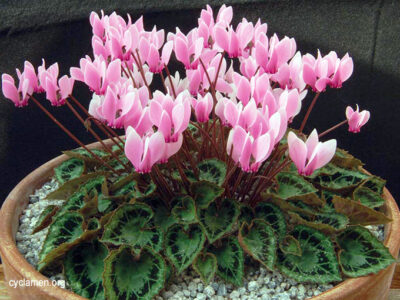Description
Flowers appear in autumn, in the wild from September to November, sometimes later, dependent on the start of the autumn rains, from pale pink to dark purplish pink but a pure white (forma album) is known, unscented or only faintly scented. The corolla lobes are reflexed, 15-25mm long, with pointed tips and generally 90 degrees twist. Darker lines on each one merge into a deeper coloured area at the nose of the flower, which has prominent auricles. Unusually among cyclamen, after fertilisation the flower stalk begins to coil from the middle rather than the top as in most species. Ssp candicum has a white or very pale pink corolla with darker, purple lines, more prominent auricles and a wider mouth to the flower.
Leaves appear late during flowering or after, dependent on the amount of rain, arising straight from the tuber, broadly oval, with a thickened slightly toothed (beaded) edge, often with a satin sheen, extremely variably patterned in shades of green, grey, silver or occasionally cream on a green ground, underside purple, sometimes greenish, 5-15cm long, 3-13cm wide.
Tuber
Tuber spherical, large at maturity, up to 20cm diameter, though a specimen weighing 17.5 kg was found in 2013, becoming very rough and flaky with age, sometimes with floral trunks, thick (3-5mm) diameter roots arise from the centre of the base.
Distribution
Cyclamen graecum ssp graecum grows in central to southern mainland Greece, the Peloponnese, the Cyclades, various islands of the eastern Aegean (but not Rhodes) and a limited area of northwest Crete. C. graecum ssp candicum is restricted to the island of Crete. (See also C. maritimum formerly ssp anatolicum)
Habitat
Cyclamen graecum grows in a typically Mediterranean climate with hot dry summers and warm wet winters, from sea level to 800m, mainly in open situations, in terra rossa over limestone, in water worn pockets or crevices in bare rock but also under scrub or in old olive groves and even in deep shade.
Cultivation
Cyclamen graecum is a tender plant, so not one for the garden outside in northwest Europe, where it is best cultivated as a pot plant in a frost-free greenhouse. The extremely variably patterned foliage is a particular attraction. The thick roots appear adapted to seeking and storing water, so it is often grown in a deep ‘long tom’ pot and watered from the base. Some water during flower bud formation seems to encourage profuse flowering.

Cyclamen graecum
subsp. candicum CSE96466,
Askifos Plain, central Crete.

Cyclamen graecum
subsp. candicum flower detail

Cyclamen graecum subsp. candicum

Cyclamen graecum subsp. candicum pink flowered form from Omalos Crete.
Cyclamen graecum subsp. candicum
An attractive subspecies generally confined to the western and central parts of the island of Crete, but there is good data that suggests that it also grows on a quite inaccessible and dangerous part of the Monte Smith escarpment on the island of Rhodes.
Flowers are white, occasionally pale pink and rarely deeper pink, all have a solid very distinctive dark magenta basal blotch, usually extending well along the veins. Leaves deep green and highly patterned with the usual satin like overlay similar to subsp. graecum but generally more narrowly ovate and pointed. The patterns tend to be darker than in subsp. graecum and the young leaves of some plants can be brownish in appearance.
Cyclamen graecum subsp. graecum is also native to Crete, restricted to the north-west of the island, the two subspecies rarely appear to grow together.

Cyclamen graecum subsp. graecum forma album
type plant, Kastania October 1980

Cyclamen graecum subsp. graecum forma album

Ronald Frank collecting the type
plant, Kastania October 1980
Cyclamen graecum subsp. graecum forma album
White forms of graecum subsp. graecum have been found in wild populations and are now relatively common in cultivation. They have entirely white flowers with the leaves no different to ordinary C. graecum, though the underside is often green.
The botanical name for this pure white flowered form is graecum subsp. graecum forma album, this name is based on a plant collected and described by Ronald and Erna Frank in the Peloponnese in 1980. It has been recorded in nature from the southern Taygetos Mountains of the Peloponnese and western Crete.












